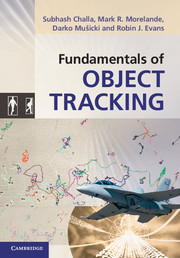Book contents
- Frontmatter
- Contents
- Preface
- 1 Introduction to object tracking
- 2 Filtering theory and non-maneuvering object tracking
- 3 Maneuvering object tracking
- 4 Single-object tracking in clutter
- 5 Single- and multiple-object tracking in clutter: object-existence-based approach
- 6 Multiple-object tracking in clutter: random-set-based approach
- 7 Bayesian smoothing algorithms for object tracking
- 8 Object tracking with time-delayed, out-of-sequence measurements
- 9 Practical object tracking
- Appendix A Mathematical and statistical preliminaries
- Appendix B Finite set statistics (FISST)
- Appendix C Pseudo-functions in object tracking
- References
- Index
9 - Practical object tracking
Published online by Cambridge University Press: 07 September 2011
- Frontmatter
- Contents
- Preface
- 1 Introduction to object tracking
- 2 Filtering theory and non-maneuvering object tracking
- 3 Maneuvering object tracking
- 4 Single-object tracking in clutter
- 5 Single- and multiple-object tracking in clutter: object-existence-based approach
- 6 Multiple-object tracking in clutter: random-set-based approach
- 7 Bayesian smoothing algorithms for object tracking
- 8 Object tracking with time-delayed, out-of-sequence measurements
- 9 Practical object tracking
- Appendix A Mathematical and statistical preliminaries
- Appendix B Finite set statistics (FISST)
- Appendix C Pseudo-functions in object tracking
- References
- Index
Summary
Chapters 1 to 8 introduced optimal (and suboptimal) Bayes tracking recursions and associated approximations.
This chapter covers some points that are important when considering the practical implementation of object tracking. It can be viewed as a collection of separate sections, each section dealing with a specific practical issue. Although object existence is often mentioned in this chapter, with due diligence and prudence the material presented can also apply to, or provide infrastructure for, other algorithms.
Section 9.2 introduces the linear multi-target method for suboptimal multiobject tracking in clutter. As the name implies, the additional numerical complexity of the linear multi-target method is linear in the number of targets and the number of measurements. This is followed by some practical methods for the clutter measurement density estimation in Section 9.3. Bayes recursion needs to be initialized; in the absence of prior target information, tracks are initialized using available measurements. Some track initialization methods and trade-offs are discussed in Section 9.4. For various reasons, multiple tracks may end following the same sequence of measurements; in Section 9.5 the track merging procedure detects and solves this situation. Finally, Section 9.6 presents some (simulated) surveillance situations and automatic target tracking solutions.
Introduction
In complex situations, involving a large number of objects and/or heavy clutter, algorithms based on the optimal multi-object approach (Section 5.5.4) may not be feasible due to its excessive computational requirements. The linear multi-target procedure to efficiently convert single-object trackers into multi-object trackers is detailed in Section 9.2.
- Type
- Chapter
- Information
- Fundamentals of Object Tracking , pp. 312 - 343Publisher: Cambridge University PressPrint publication year: 2011
- 1
- Cited by

